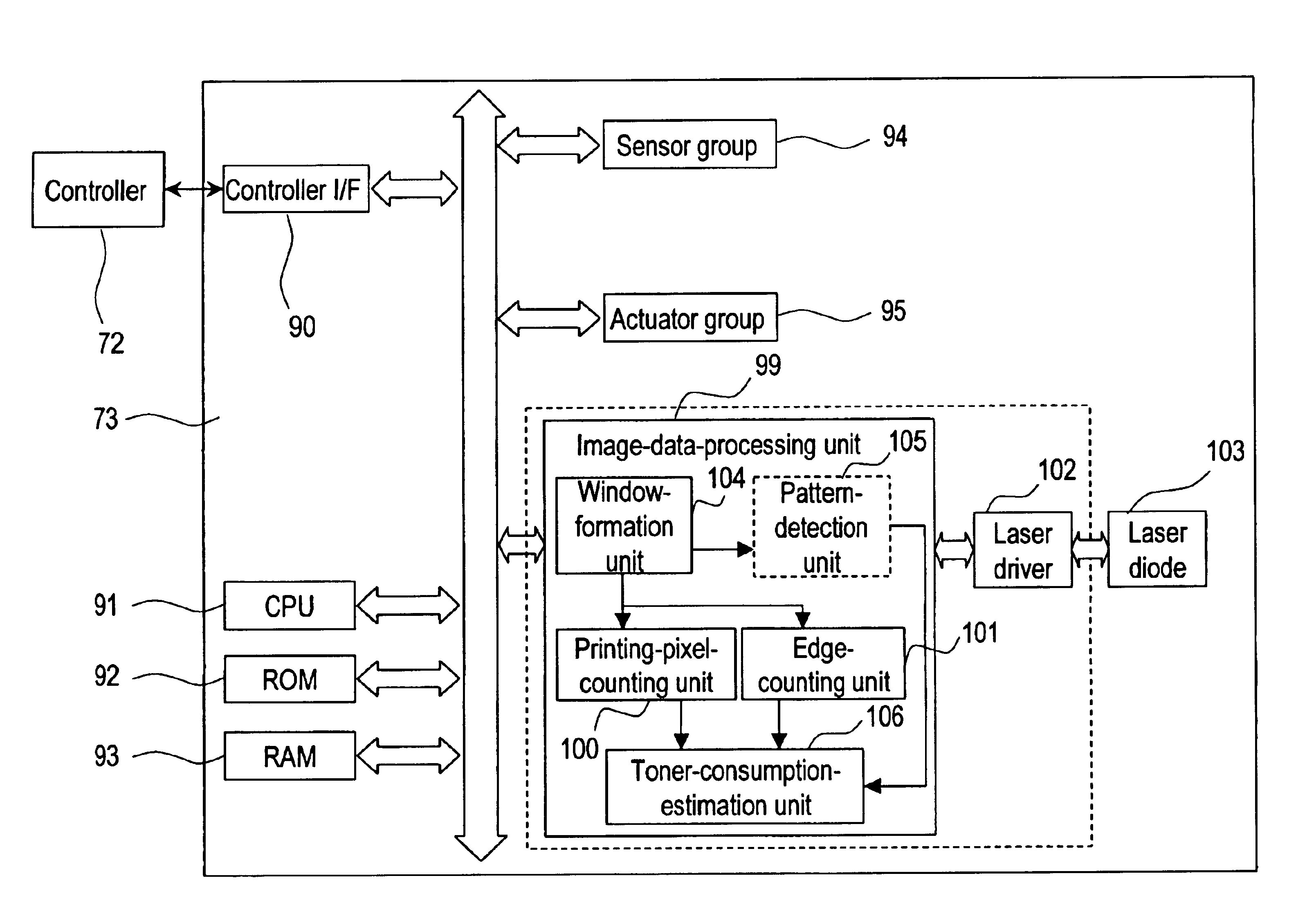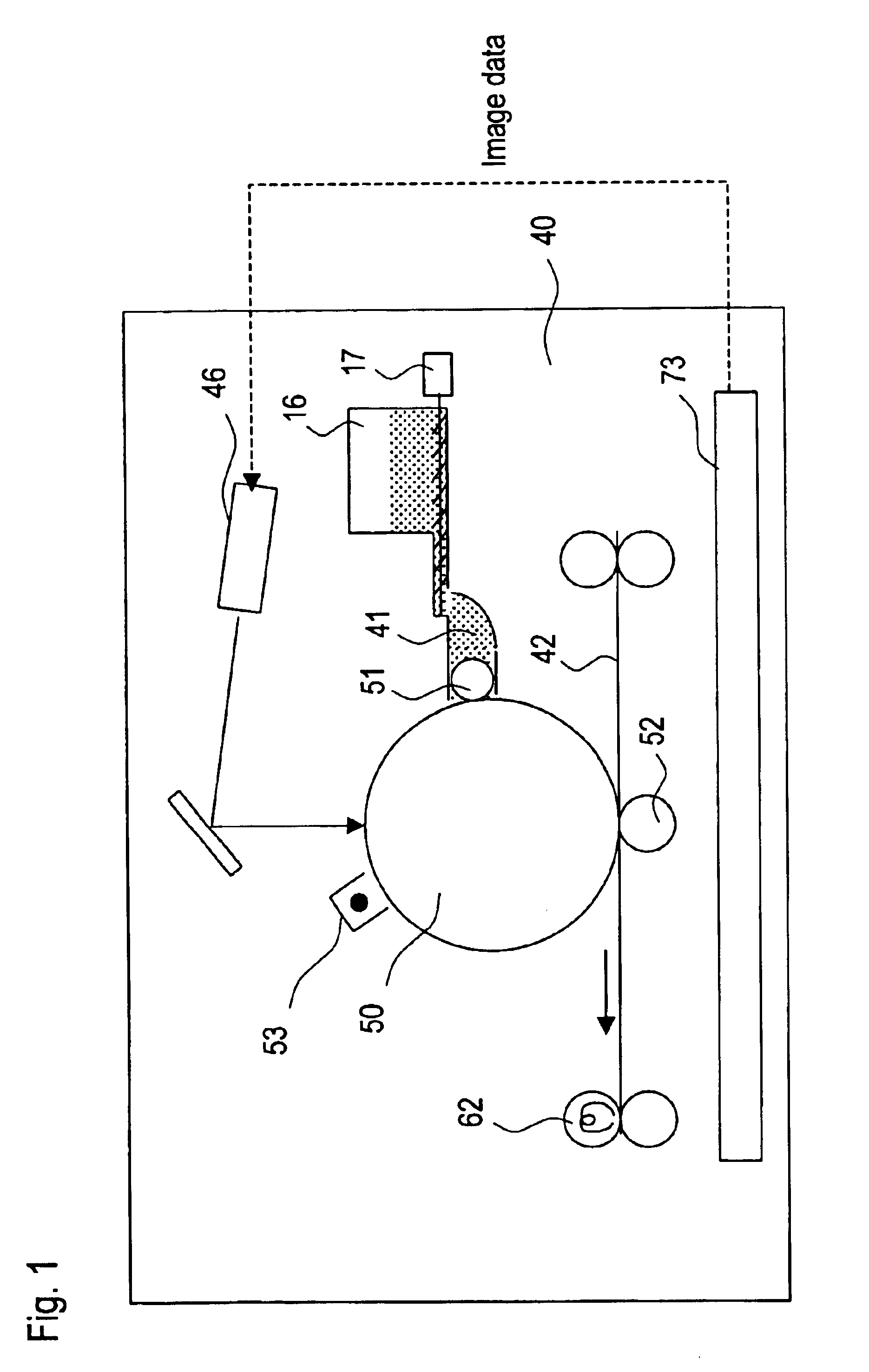Image forming apparatus and method for estimating the amount of toner consumption
a technology of toner consumption and forming apparatus, which is applied in the direction of electrographic process, electrographic process using charge pattern, instruments, etc., can solve the problems of high cost of sensors, increase in actual error in the amount of consumed toner, etc., and achieve high precision
- Summary
- Abstract
- Description
- Claims
- Application Information
AI Technical Summary
Benefits of technology
Problems solved by technology
Method used
Image
Examples
embodiment 1
(Embodiment 1)
[0037]The image forming apparatus of a first embodiment of the invention will be explained in detail with reference to FIG. 1 to FIG. 7.
[0038]In FIG. 1, the image forming apparatus 40 emits a laser light from the exposure unit 46 based on image data that are sent from the printer-engine-control unit 73. The laser is irradiated on the photosensitive element 50 whose surface is uniformly charged by a charging unit 53. The surface electric potential of the part on the photosensitive element 50 that is irradiated by the laser changes, and a latent image is formed. Toner particles are caused to adhere to the latent image by the developing sleeve 51 in the developer 41, which is the developing unit, to form an image on the photosensitive element. The image that is formed is transferred to the paper 42 by a transfer roller 52, which is the transfer unit, to form an image on the paper. The toner on the paper 42 on which the image is formed is fixed by the fixation unit 62, and...
embodiment 2
(Embodiment 2)
[0091]In the first embodiment, a method of estimating the amount of consumed toner taking into consideration the dot thickness in the main-scanning direction and sub-scanning direction was described. However, as shown in FIG. 3D, depending on the apparatus, there are cases when the toner that is to adhere to the pixel 309 protrudes from the pixel diagonally from the corners 310. In this kind of situation, errors occur even when using the method of the first embodiment.
[0092]Therefore, in this second embodiment, a method of estimating the amount of consumed toner based on the location of the printing pixels in the windows will be explained. Explanations of parts that are common with the first embodiment will be omitted.
[0093]In this embodiment, the image-data-processing unit 99 comprises a pattern-detection unit 105 instead of the printing-pixel-counting unit 100 and edge-counting unit 101. The pattern-detection unit 105 comprises 2 to the 9th power (512) comparison cir...
embodiment 3
(Embodiment 3)
[0099]In the first embodiment, a method of estimating the amount of consumed toner taking into consideration the dot thickness in the main-scanning direction and sub-scanning direction was described. Also, in the second embodiment, a method of estimating the amount of consumed toner taking into consideration the dot thickness in the diagonal corners was described. However, in the case of an isolated pixel as shown in FIG. 3C, the amount toner that is consumed is less than in the case of a normal pixel. In this case, errors will occurs when using the methods described in the first and second embodiments.
[0100]That is, with the art described in the first embodiment, the number of edges counted for the isolated pixel is 4, so the amount of consumed toner that is calculated is greater than the actual amount. Also, in the case of the second embodiment, when it is detected that the portion of the pixel i shown in FIG. 7 is a printing pixel, it is not possible to determine wh...
PUM
 Login to View More
Login to View More Abstract
Description
Claims
Application Information
 Login to View More
Login to View More - R&D
- Intellectual Property
- Life Sciences
- Materials
- Tech Scout
- Unparalleled Data Quality
- Higher Quality Content
- 60% Fewer Hallucinations
Browse by: Latest US Patents, China's latest patents, Technical Efficacy Thesaurus, Application Domain, Technology Topic, Popular Technical Reports.
© 2025 PatSnap. All rights reserved.Legal|Privacy policy|Modern Slavery Act Transparency Statement|Sitemap|About US| Contact US: help@patsnap.com



